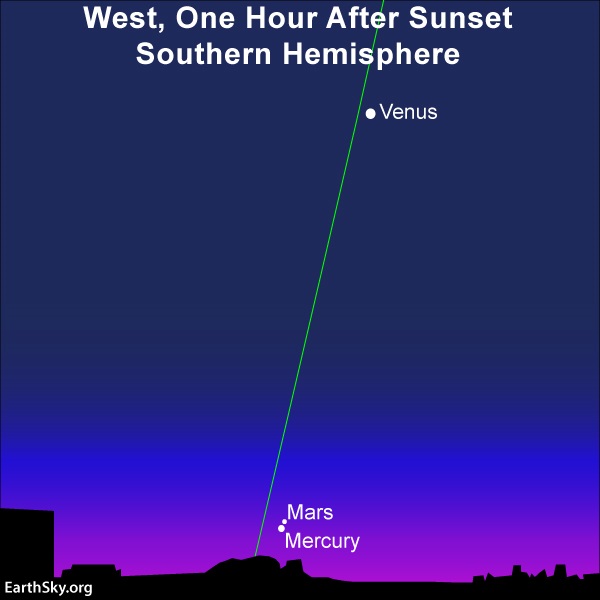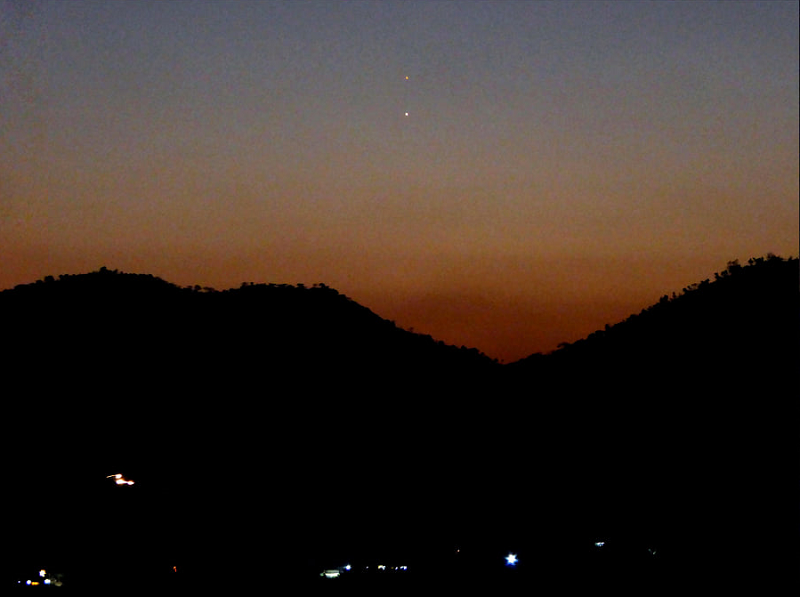
2021’s closest planetary conjunction favors Southern Hemisphere
The closest conjunction of two planets for 2021 happens on August 19 at 04:10 UTC. Depending on where you live worldwide, Mercury and Mars will appear at their closest on the sky’s dome at evening dusk on either August 18 or August 19. They are exceedingly low in the west after sunset. Look first for dazzling Venus, the sky’s brightest planet, above the sunset point. Then, as twilight deepens, search for these two embracing worlds beneath Venus, and close to the horizon.
We give you fair warning! It’ll be easier to catch the evening couple from Earth’s Southern Hemisphere than at northerly latitudes. That’s why we chose Montevideo, Uruguay (35 degrees south latitude) for our sky chart at top. Mercury and Mars stay out longer after sunset at more southerly latitudes. Conversely, they set sooner after sunset at more northerly latitudes.

From mid-northern latitudes, you may well need binoculars to see Mercury and Mars. Mercury is the brighter of these two worlds, shining a good 8 times more brilliantly than Mars. So if you spot Mercury, but not Mars, try using binoculars to reel in Mars. Most likely, you’ll see Mars snuggling up with Mercury in a single binocular field.
Mercury/Mars setting times
We provide the approximate setting times for Mercury, the brighter planet, at various latitudes:
40 degrees north latitude: Mercury sets 3/4 hour (45 minutes) after sunset
Equator (0 degrees latitude): Mercury sets one hour (60 minutes) after sunset
35 degrees south latitude: Mercury sets 1 1/4 hours (75 minutes) after sunset
Want more specific information? Go to timeanddate.com (worldwide) or Old Farmer’s Almanac (U.S. and Canada).
Definition of planetary conjunction
Two planets are said to be in conjunction when they reside north and south of one another in right ascension. Right ascension on the celestial sphere is the equivalent of longitude on Earth’s surface.
Mercury swings less than 0.1 degree south of Mars on August 19. If you can catch it, you’ll witness the closest planetary conjunction in all of 2021.
For some context, the moon’s angular diameter spans about 0.5 degree. Therefore, 0.1 degree on the sky’s dome is equal to about 1/5th of the moon’s diameter.
Close conjunction indeed!
We define a close planetary conjunction as two planets less than 0.1 degree apart on the sky’s dome. By that definition, the Mercury-Mars conjunction on August 19 counts as the only close planetary conjunction in 2021. Generally, two planets come closest together at or near conjunction. However, the term appulse specifically refers to the least distance between two heavenly bodies.
Appulse and conjunction usually don’t occur simultaneously. As for Mercury and Mars, the least distance (appulse) comes on August 19 at 03:18 UTC. Conjunction occurs nearly an hour later, at 04:10 UTC. We list the angular separation at appulse and conjunction below in seconds of arc. (For reference, 0.1 degree = 6 arcminutes = 360 arcseconds.)
August 19 Mercury-Mars conjunction
Appulse (August 19, at 3:18 UTC): 255 arcseconds
Conjunction (August 19, at 4:10 UTC): 289 arcseconds
Source: page 47 of Astronomical Tables of the Sun, Moon and Planets (3rd Edition) by Jean Meeus.
Past and future planetary conjunctions
The last time Mercury and Mars showcased a closer conjunction was on September 16, 2017. The next time won’t be until August 23, 2032.
We have close planetary conjunctions (two planets less than 0.1 degree apart) in intervening years as well. Most generally, a single year has one close planetary conjunction. Between the years 2017 to 2032, two years have two close conjunctions (2018, 2032), while four have none (2019, 2025, 2027, 2029). Yet, all these intervening conjunctions involve either Uranus or Neptune. And these distant worlds are not readily visible to the eye alone. You usually need an optical aid to view Uranus, and absolutely need one to see Neptune.
Therefore, the last time two visible planets staged a close conjunction (<0.1 degree) was in 2017. Next time will be 2032.
Close planetary conjunctions 2017 to 2032
2017 Sep 16 Mercury-Mars
2018 Mar 29 Venus-Uranus
2018 Dec 07 Mars-Neptune
2020 Jan 27 Venus-Neptune
2021 Aug 19 Mercury-Mars
2022 Apr 27 Venus-Neptune
2023 Feb 15 Venus-Neptune
2024 Apr 29 Mars-Neptune
2026 Mar 07 Venus-Neptune
2030 Jun 18 Mercury-Uranus
2032 Apr 17 Venus-Neptune
2032 Aug 23 Mercury-Mars
Source: page 47 of Astronomical Tables of the Sun, Moon and Planets (3rd Edition) by Jean Meeus.
Closer Mercury-Mars conjunction on August 23, 2032
Mercury and Mars will be spectacularly close on August 19, 2021. Yet, on August 23, 2032, Mercury and Mars will appear 16 times closer.
Conjunction (August 23, at 4:23 UTC): 16 arcseconds
Appulse (August 19, at 4:24 UTC): 16 arcseconds
Source: page 47 of Astronomical Tables of the Sun, Moon and Planets (3rd Edition) by Jean Meeus.
Bottom line: Take advantage of your golden opportunity to see the close pairing of two visible planets – Mercury and Mars – after sunset August 18 and 19, 2021. It’ll be the closest encounter between two visible planets until August 23, 2032!











